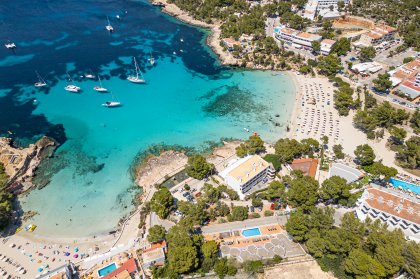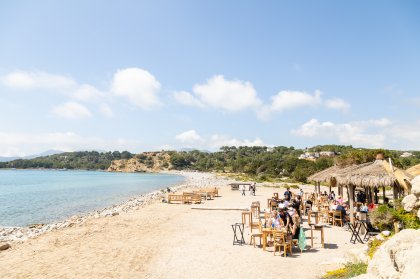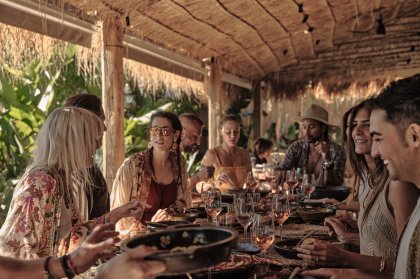Ibiza as an island in the Mediterranean sea would seem to have a plethora of delicious fresh local seafood. The truth is that most of the seafood goes first through Barcelona or Valencia, is farmed, or is flown in from far away, usually in a combination thereof. Think Panga, both farmed and flown from afar. Local seafood is something different, special.
Nothing tastes quite as fresh as fish or shellfish, just hours out of the sea. It has a unique flavour - it tastes like the sea smells, cool, salty and refreshing. Ibiza seafood makes for fantastic eating, and so it is well worth knowing where it can be found. And, interestingly, new discoveries abound - strange and wonderful creatures inhabit the Balearic Sea.
New Discovery

Cigala Ibicenca or Cigala Real is a fascinating brown, rectangular crustacean, edged in bright purple, with a segmented, lobster like tail, orange eyes where ears should be and paddles on the front of its head, positively prehistoric and absolutely delicious.
It lives hidden among the coastal rocks, and can be caught most of year, but is in season in May, June and July. It was a completely new discovery, when to my astonishment it came up in the net whilst fishing with Portinatx Fisherman, Juanito. Frankly, I wondered who the first brave and hungry soul might have been to think up cooking and eating it. It truly looks like that.
Juanito was delighted, as aside from being an absolute delicacy, it is the most expensive of the shellfish and relatively uncommon.

Excited by the discovery, it was immediately off to Juanito’s family restaurant, Los Pinos, Portinatx to taste the bizarre looking Cigala cooked into a Paella by his father, Vincente. And what a sublime treat it was, truly the best Paella ever.
Vincente has been making Paella for 35 years and his experience is evident. Clean, fresh flavour, perfectly cooked, al dente rice, fresh chunks of delicate white fish, and cigala cut in to four, served in the shell.
The cigala, crayfish in English, most closely resembles lobster in body, flavour and texture. Most of the meat is in the tail, and is more tender and sweet. My lovely Ibicenco friend, Maria Jose, said it just has to be eaten at least once, at around forty five euros per person, this is so. If the wallet can accommodate, it is not to be missed.
Buying Local Seafood

- see below for where to buy.
The easiest way to sort out what is local when shopping is by reading the label. Fish shops, markets and grocery stores are required to provide price, method, (farmed or wild) and origin. Look for a little red and yellow Balearic logo on the bottom left hand corner. When in a restaurant, enquire. Generally, it is the smaller local restaurants that have local fish. Either the restaurant will have a fisherman in the family or will have a contract with one. It is against the rules for fisherman to sell outside of the contract. Sadly, that means no heading down to the dock, a thing of the past, for most of the world at this point.
What Seafood to Eat When:
Generally speaking, while they all have their seasons, a lot of the fish and seafood are available a lot of the time, just not in equal abundance. It is almost always possible to get some variety of white fleshed fish, oily fish, or shellfish and Calamari is available year round.
Winter is the low season; the water is cold and rough and the fish scarce.
Autumn: Look for big white fish, the little half kilo to kilo denton fish have grown up, sometimes to 20 kilos or more. Also in season are Sirvia, lubina, Salmonetes, and Calalmari are line caught beginning in September.
Spring: Look for langosta, reddish and lobster like, in the beginning of May, also Cigala Ibicenca thru June. Sepia/Cuttlefish and Calamari are abundant.
Summer: Sea ray is in season. Traditionally, dried in the sun and stored in oil, often eaten on salads. Denton, Lubina, Rotja, etc are also available. Balearic shrimp, the only fresh, non-frozen shrimp, come in off the big shrimp boats. September is the only month for the very special Roan. Small, sweet and very expensive, it is a must have at least one per year.

Recipe:
Everyone has a favourite paella place or a favoured recipe, there are nearly as many as there are Spaniards. This is a good basic recipe, easily adapted to personal taste. Don’t worry - seafood paella does not require the Cigala and can be made with similar quantities of any fish or shellfish.
Seafood Paella,
- adapted from Claudia Rodin’s ‘The Food of Spain’
1 large Onion, medium chop
1 large red pepper, medium chop
5 Tablespoons olive oil
4 garlic cloves, crushed
500 gm fresh tomatoes, rough chop
1/2 teaspoon brown sugar
1 teaspoon sweet paprika, pimenton dulce
1 big pinch saffron threads
4 small squid, cleaned and sliced in 4 pieces
600 gr Sirvia steaks
1 roasted red pepper, skinned, de-seeded and cut into strips
400 gr Spanish rice, medium grain
750 ml fish stock and white wine brought to a boil
250 ml white wine
16 large raw shrimp
32 small Spanish clams
16 mussels

Sauté the onion and red pepper in the oil until soft, but not brown. Add the garlic, and a minute later the tomatoes, sugar, a big pinch of sea salt, paprika, and saffron. Cook until reduced to a thick sauce. Add the fish steaks, using tongs turn to coat and sauté partially, remove so they don’t get broken up. Add the squid, again turn to coat and remove. Add the rice, stir to coat the grains and sauté to lightly toast the rice. Pour the boiling liquid over the rice, add the roasted red pepper and stir to distribute, Return the fish and squid to the pan, evenly distributed and nestle it down into the rice and stock. Cook over low heat for 15 minutes or so, place shrimp evenly on top, after 10 minutes turn the shrimp. If liquid has completely evaporated and the pan is sizzling like something is frying rather than boiling, add a cup or two more. This is a bit of a judgement, like cooking risotto, so just taste to determine if it needs more liquid and to see when it’s done. Cover with foil and let it sit. Meanwhile, steam the mussels and clams in a covered pan until just open, discard the closed ones. Arrange on platter and serve.
I like to serve paella with aioli and lemon wedges.
Where to Buy Local Seafood.

Es Mercat, Santa Eulalia Del Rio Market:
All four of the stalls sell local: seafood, Open 8:00 until 2:00, Tuesday thru Saturday.
Pescaderia Juani: 971 331 418
Pescados Y Mariscos Murtera: 971 332 140, 607 910 773
Pescado Juamet: 971 338 771, 616 119 381
Consuelo & Pardalet 971 331 024, 659 539 099
Pescaderia San Juan; Village Center, San Juan: 971 333 417, 680 254 381
Seafood Department at the Syp, Ibiza Town
For Cigala Ibicenca or any other of their delicious paellas or local specialties:
Los Pinos Playa, Portinax: 971 320 574
Open 7 days a week April thru October







